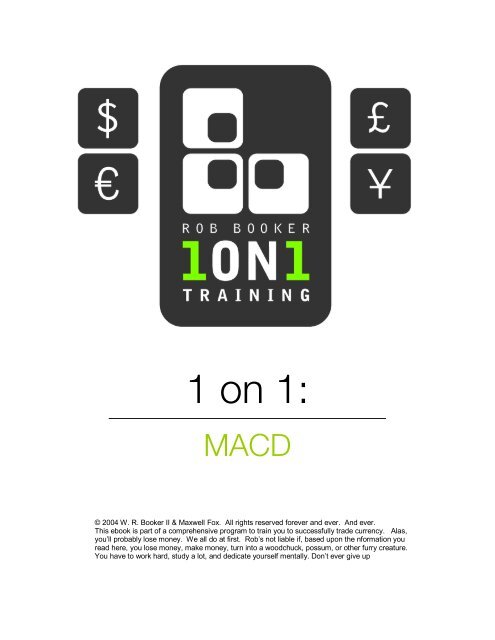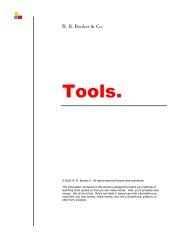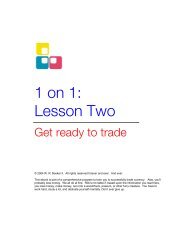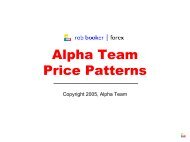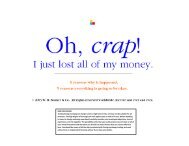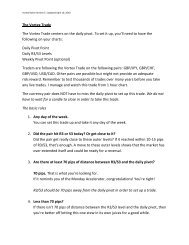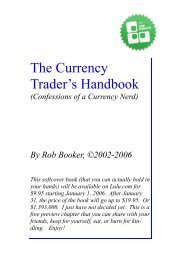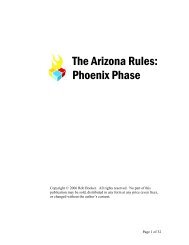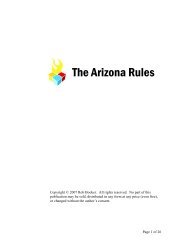1 on 1: - Rob Booker
1 on 1: - Rob Booker
1 on 1: - Rob Booker
Create successful ePaper yourself
Turn your PDF publications into a flip-book with our unique Google optimized e-Paper software.
1 <strong>on</strong> 1:<br />
MACD<br />
© 2004 W. R. <strong>Booker</strong> II & Maxwell Fox. All rights reserved forever and ever. And ever.<br />
This ebook is part of a comprehensive program to train you to successfully trade currency. Alas,<br />
you’ll probably lose m<strong>on</strong>ey. We all do at first. <strong>Rob</strong>’s not liable if, based up<strong>on</strong> the nformati<strong>on</strong> you<br />
read here, you lose m<strong>on</strong>ey, make m<strong>on</strong>ey, turn into a woodchuck, possum, or other furry creature.<br />
You have to work hard, study a lot, and dedicate yourself mentally. D<strong>on</strong>’t ever give up
1<br />
Moving Average C<strong>on</strong>vergence Divergence (MACD)<br />
MACK-D<br />
MACD is arguably the most versatile indicator available <strong>on</strong> pretty much all charting<br />
software packages. You can use it to judge momentum, or as an oscillator (for<br />
ascertaining overbought and oversold c<strong>on</strong>diti<strong>on</strong>s), or to slice and dice vegetables quickly<br />
and efficiently.<br />
But wait! There’s more!<br />
For the purpose of this learning sessi<strong>on</strong>, we will use the default settings of 12, 26, 9.<br />
You may find that when you test using the MACD that you want to use alternate settings.<br />
And that’s fine. But I have always stayed with the regular old standard settings.<br />
The Standard MACD indicator is made up of 3 parts:<br />
1. The MACD Line - the difference between a 12 period EMA and a 26 period<br />
EMA.<br />
2. The Trigger Line - a 9 period EMA of the MACD line<br />
3. The Histogram - shows the difference between MACD line and Trigger line.<br />
All of these lines and histogram move back and forth over a “center” or “zero” line. We<br />
will go over an example of which line is which in an example below.<br />
When a market is volatile, all of the parts of MACD will make wide swings <strong>on</strong> either side<br />
of the zero line. When a market is relatively quiet, the moving averages that comprise<br />
MACD will come together, making MACD itself c<strong>on</strong>solidate <strong>on</strong> the zero line.<br />
MACD is therefore a good indicator for measuring volatility and momentum.<br />
Possible trading signals come from MACD in the forms of:<br />
Line Crosses<br />
Rollovers/Rollups<br />
Divergences<br />
We’ll talk about each of those in turn, but first you should know that because MACD<br />
oscillates over a “center line,” it gives no indicati<strong>on</strong> of trend. It is therefore up to you as<br />
the analyst to determine the directi<strong>on</strong> of the trend and <strong>on</strong>ly take signals that go in its<br />
directi<strong>on</strong>. If you identify a ranging market you may take positi<strong>on</strong>s in either directi<strong>on</strong> but<br />
use smaller profit targets.
These are the Exp<strong>on</strong>ential Moving Averages (EMA) from which the MACD is created.<br />
The Red Line is a 12 period EMA, and the Magenta Line is a 26 period EMA.<br />
2
The MACD Line is the first element. The MACD line is the measures the relative<br />
distance between the 12 & 26 period EMAs. If the 12 is above the 26, then the MACD<br />
line is above zero. Inversely, if the 12 is below the 26, then the MACD line is below<br />
zero.<br />
3
Here you see the points where the EMAs are crossing each other and where the MACD<br />
line is crossing zero.<br />
4
Because the MACD line measures the difference between the EMAs, it always equals<br />
zero when the EMAs are equal to each other.<br />
5
6<br />
The next element of the whole MACD indicator is the slow or trigger line. It is a 9<br />
period EMA of the MACD line.<br />
In the same way that a moving average is made up of the average value of close prices for<br />
a given number of time periods, the trigger line is made up of average values of the<br />
MACD line for a given number of periods. 9 is the given number, in the case of the<br />
default settings. If this was c<strong>on</strong>fusing to you, I will tell you that this was c<strong>on</strong>fusing to me<br />
at first, too. I simply drilled some holes in my head, dumped out some old informati<strong>on</strong>,<br />
and then re-read the paragraph above.<br />
People tend to say that MACD is giving a “bullish signal” when the MACD line crosses<br />
above the trigger line. In the same way, it is said to be a bearish signal when the MACD<br />
line crosses below the trigger line.
The blue dotted vertical line marks the bullish MACD cross, and the red dotted line<br />
marks the bearish MACD cross.<br />
7
8<br />
The final piece of the MACD indicator is the histogram. The histogram measures the<br />
relative distance between the MACD line and the Trigger line.<br />
It is true that you can just see the difference between the MACD and the Trigger lines,<br />
just by looking at them. But the histogram is even more visual and easy to see. It<br />
reminds me of the bars <strong>on</strong> my cell ph<strong>on</strong>e. Which has nothing to do with trading, but I<br />
thought I would say that anyway.
The histogram can be used to show divergences (in depth less<strong>on</strong> later)<br />
A divergence is meant to show a losing of momentum. Here we have a lower high <strong>on</strong> the<br />
price chart is followed by a higher high, while at the same time the histogram is showing<br />
a higher high followed by a lower high.<br />
This is a bearish divergence. It shows that while price manages to creep higher, it does<br />
so with less enthusiasm than when the move started and we can expect a retracement of<br />
some kind. As we can see <strong>on</strong> the right side, a retracement is exactly what happened.<br />
9
10<br />
I made a couple little step doohickies <strong>on</strong> the histogram to show what a rollover and rollup<br />
might look like. The blue <strong>on</strong>e showing a rollover. The green <strong>on</strong>e showing a rollup.<br />
Here is a powerful way to use the MACD:<br />
When the histogram makes a peak, it starts to print progressively lower bars. When you<br />
see a nice MACD rally upward followed by 2 or 3 declining bars, you are looking at the<br />
first sign of a “rollover”. This is a bearish signal. We call it a rollover because the<br />
MACD is rolling over, as a ball might roll over a hill. It is very quick to give a signal,<br />
and therefore is pr<strong>on</strong>e to whipsaws.<br />
To avoid whipsaws, it’s a good idea to add a couple extra criteria. An<br />
overbought/Oversold indicator would help (like Stochastic, RSI, or CCI). Trend
11<br />
determinati<strong>on</strong> would also help. Waiting for the high or low of your signal candle to be<br />
broken could also help.<br />
What did we learn?<br />
• The MACD indicator is made up of the MACD line, the trigger line, and the<br />
histogram.<br />
• The MACD indicator is vast in its range of analysis functi<strong>on</strong>s, yet it begins with<br />
<strong>on</strong>ly 2 moving averages.<br />
• MACD can be a powerful place to start a technical system.


